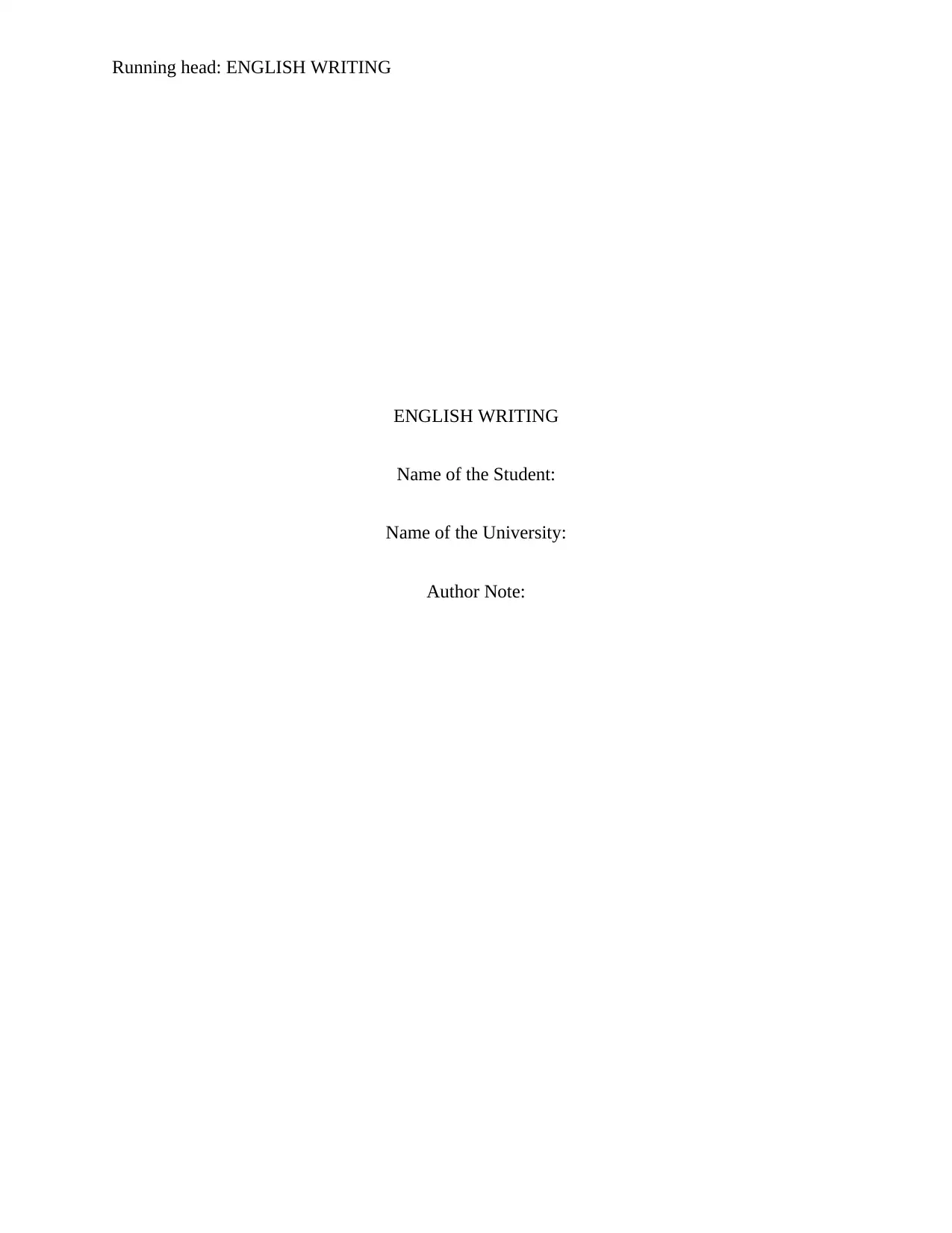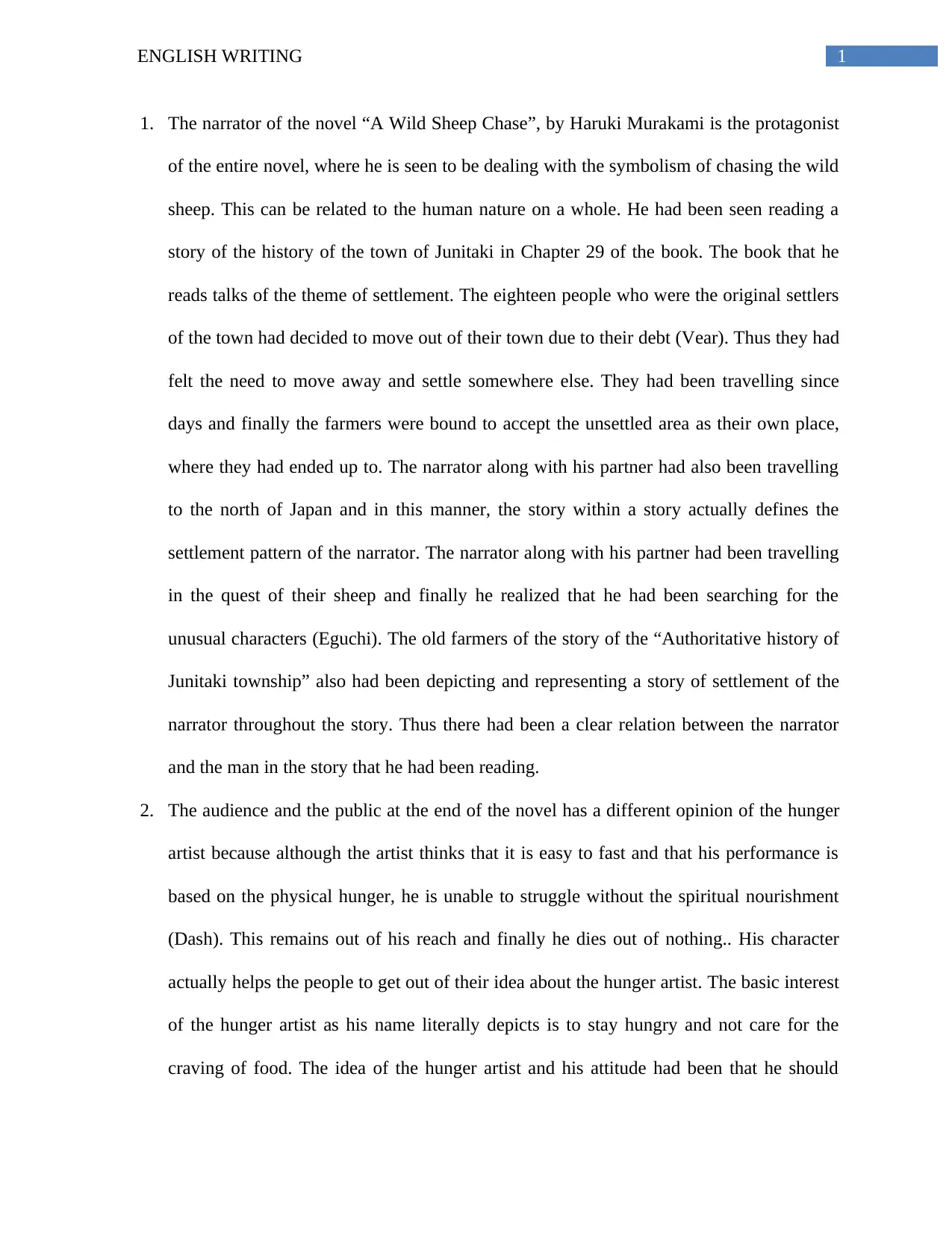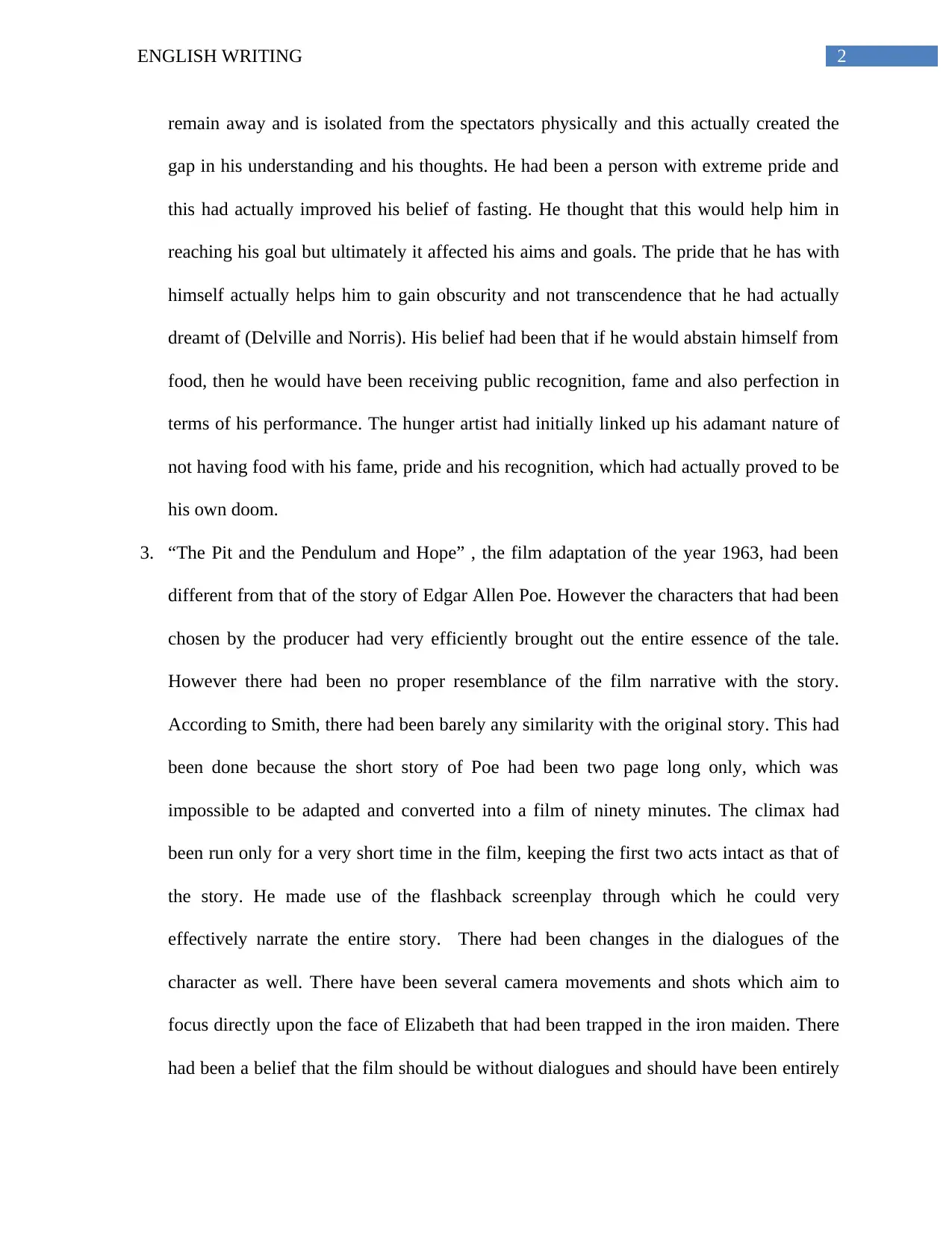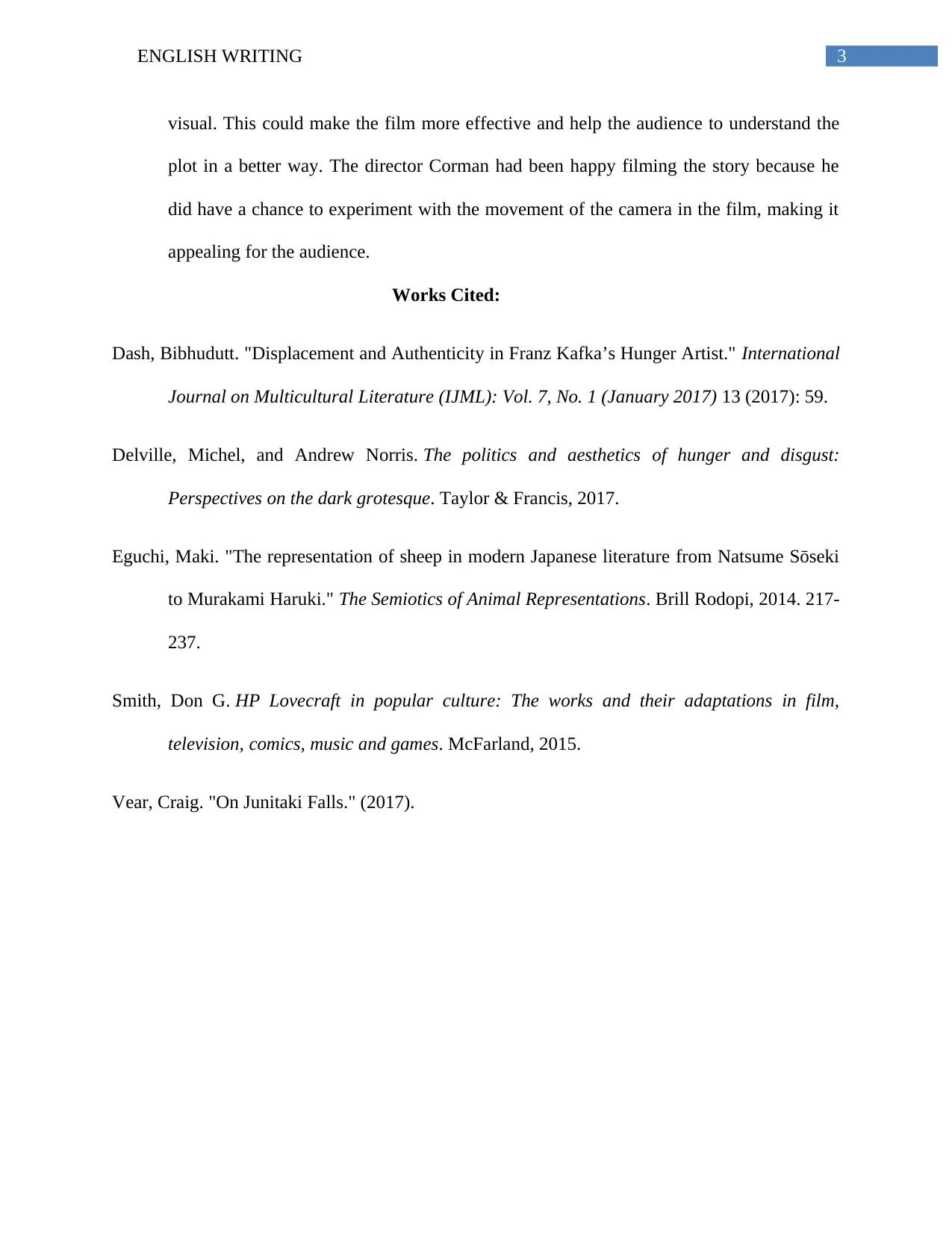English Writing: Analysis of Literary Works and Film
VerifiedAdded on 2022/09/18
|4
|1002
|21
Essay
AI Summary
This essay analyzes several literary works and their film adaptations. It begins with an examination of Haruki Murakami's 'A Wild Sheep Chase,' focusing on the protagonist's quest and the symbolism of settlement, drawing parallels between the narrator's journey and the history of Junitaki. The essay then delves into Franz Kafka's 'The Hunger Artist,' exploring the artist's character, his isolation, and the public's perception of his performance. Finally, it compares Edgar Allan Poe's 'The Pit and the Pendulum' with its 1963 film adaptation, discussing the changes made for the screen, the use of flashbacks, and the director's experimentation with camera movement to enhance the narrative. The essay uses various sources to support its arguments, providing a comparative analysis of the themes, characters, and narrative techniques employed in both literary and cinematic works.

Running head: ENGLISH WRITING
ENGLISH WRITING
Name of the Student:
Name of the University:
Author Note:
ENGLISH WRITING
Name of the Student:
Name of the University:
Author Note:
Paraphrase This Document
Need a fresh take? Get an instant paraphrase of this document with our AI Paraphraser

1ENGLISH WRITING
1. The narrator of the novel “A Wild Sheep Chase”, by Haruki Murakami is the protagonist
of the entire novel, where he is seen to be dealing with the symbolism of chasing the wild
sheep. This can be related to the human nature on a whole. He had been seen reading a
story of the history of the town of Junitaki in Chapter 29 of the book. The book that he
reads talks of the theme of settlement. The eighteen people who were the original settlers
of the town had decided to move out of their town due to their debt (Vear). Thus they had
felt the need to move away and settle somewhere else. They had been travelling since
days and finally the farmers were bound to accept the unsettled area as their own place,
where they had ended up to. The narrator along with his partner had also been travelling
to the north of Japan and in this manner, the story within a story actually defines the
settlement pattern of the narrator. The narrator along with his partner had been travelling
in the quest of their sheep and finally he realized that he had been searching for the
unusual characters (Eguchi). The old farmers of the story of the “Authoritative history of
Junitaki township” also had been depicting and representing a story of settlement of the
narrator throughout the story. Thus there had been a clear relation between the narrator
and the man in the story that he had been reading.
2. The audience and the public at the end of the novel has a different opinion of the hunger
artist because although the artist thinks that it is easy to fast and that his performance is
based on the physical hunger, he is unable to struggle without the spiritual nourishment
(Dash). This remains out of his reach and finally he dies out of nothing.. His character
actually helps the people to get out of their idea about the hunger artist. The basic interest
of the hunger artist as his name literally depicts is to stay hungry and not care for the
craving of food. The idea of the hunger artist and his attitude had been that he should
1. The narrator of the novel “A Wild Sheep Chase”, by Haruki Murakami is the protagonist
of the entire novel, where he is seen to be dealing with the symbolism of chasing the wild
sheep. This can be related to the human nature on a whole. He had been seen reading a
story of the history of the town of Junitaki in Chapter 29 of the book. The book that he
reads talks of the theme of settlement. The eighteen people who were the original settlers
of the town had decided to move out of their town due to their debt (Vear). Thus they had
felt the need to move away and settle somewhere else. They had been travelling since
days and finally the farmers were bound to accept the unsettled area as their own place,
where they had ended up to. The narrator along with his partner had also been travelling
to the north of Japan and in this manner, the story within a story actually defines the
settlement pattern of the narrator. The narrator along with his partner had been travelling
in the quest of their sheep and finally he realized that he had been searching for the
unusual characters (Eguchi). The old farmers of the story of the “Authoritative history of
Junitaki township” also had been depicting and representing a story of settlement of the
narrator throughout the story. Thus there had been a clear relation between the narrator
and the man in the story that he had been reading.
2. The audience and the public at the end of the novel has a different opinion of the hunger
artist because although the artist thinks that it is easy to fast and that his performance is
based on the physical hunger, he is unable to struggle without the spiritual nourishment
(Dash). This remains out of his reach and finally he dies out of nothing.. His character
actually helps the people to get out of their idea about the hunger artist. The basic interest
of the hunger artist as his name literally depicts is to stay hungry and not care for the
craving of food. The idea of the hunger artist and his attitude had been that he should

2ENGLISH WRITING
remain away and is isolated from the spectators physically and this actually created the
gap in his understanding and his thoughts. He had been a person with extreme pride and
this had actually improved his belief of fasting. He thought that this would help him in
reaching his goal but ultimately it affected his aims and goals. The pride that he has with
himself actually helps him to gain obscurity and not transcendence that he had actually
dreamt of (Delville and Norris). His belief had been that if he would abstain himself from
food, then he would have been receiving public recognition, fame and also perfection in
terms of his performance. The hunger artist had initially linked up his adamant nature of
not having food with his fame, pride and his recognition, which had actually proved to be
his own doom.
3. “The Pit and the Pendulum and Hope” , the film adaptation of the year 1963, had been
different from that of the story of Edgar Allen Poe. However the characters that had been
chosen by the producer had very efficiently brought out the entire essence of the tale.
However there had been no proper resemblance of the film narrative with the story.
According to Smith, there had been barely any similarity with the original story. This had
been done because the short story of Poe had been two page long only, which was
impossible to be adapted and converted into a film of ninety minutes. The climax had
been run only for a very short time in the film, keeping the first two acts intact as that of
the story. He made use of the flashback screenplay through which he could very
effectively narrate the entire story. There had been changes in the dialogues of the
character as well. There have been several camera movements and shots which aim to
focus directly upon the face of Elizabeth that had been trapped in the iron maiden. There
had been a belief that the film should be without dialogues and should have been entirely
remain away and is isolated from the spectators physically and this actually created the
gap in his understanding and his thoughts. He had been a person with extreme pride and
this had actually improved his belief of fasting. He thought that this would help him in
reaching his goal but ultimately it affected his aims and goals. The pride that he has with
himself actually helps him to gain obscurity and not transcendence that he had actually
dreamt of (Delville and Norris). His belief had been that if he would abstain himself from
food, then he would have been receiving public recognition, fame and also perfection in
terms of his performance. The hunger artist had initially linked up his adamant nature of
not having food with his fame, pride and his recognition, which had actually proved to be
his own doom.
3. “The Pit and the Pendulum and Hope” , the film adaptation of the year 1963, had been
different from that of the story of Edgar Allen Poe. However the characters that had been
chosen by the producer had very efficiently brought out the entire essence of the tale.
However there had been no proper resemblance of the film narrative with the story.
According to Smith, there had been barely any similarity with the original story. This had
been done because the short story of Poe had been two page long only, which was
impossible to be adapted and converted into a film of ninety minutes. The climax had
been run only for a very short time in the film, keeping the first two acts intact as that of
the story. He made use of the flashback screenplay through which he could very
effectively narrate the entire story. There had been changes in the dialogues of the
character as well. There have been several camera movements and shots which aim to
focus directly upon the face of Elizabeth that had been trapped in the iron maiden. There
had been a belief that the film should be without dialogues and should have been entirely
⊘ This is a preview!⊘
Do you want full access?
Subscribe today to unlock all pages.

Trusted by 1+ million students worldwide

3ENGLISH WRITING
visual. This could make the film more effective and help the audience to understand the
plot in a better way. The director Corman had been happy filming the story because he
did have a chance to experiment with the movement of the camera in the film, making it
appealing for the audience.
Works Cited:
Dash, Bibhudutt. "Displacement and Authenticity in Franz Kafka’s Hunger Artist." International
Journal on Multicultural Literature (IJML): Vol. 7, No. 1 (January 2017) 13 (2017): 59.
Delville, Michel, and Andrew Norris. The politics and aesthetics of hunger and disgust:
Perspectives on the dark grotesque. Taylor & Francis, 2017.
Eguchi, Maki. "The representation of sheep in modern Japanese literature from Natsume Sōseki
to Murakami Haruki." The Semiotics of Animal Representations. Brill Rodopi, 2014. 217-
237.
Smith, Don G. HP Lovecraft in popular culture: The works and their adaptations in film,
television, comics, music and games. McFarland, 2015.
Vear, Craig. "On Junitaki Falls." (2017).
visual. This could make the film more effective and help the audience to understand the
plot in a better way. The director Corman had been happy filming the story because he
did have a chance to experiment with the movement of the camera in the film, making it
appealing for the audience.
Works Cited:
Dash, Bibhudutt. "Displacement and Authenticity in Franz Kafka’s Hunger Artist." International
Journal on Multicultural Literature (IJML): Vol. 7, No. 1 (January 2017) 13 (2017): 59.
Delville, Michel, and Andrew Norris. The politics and aesthetics of hunger and disgust:
Perspectives on the dark grotesque. Taylor & Francis, 2017.
Eguchi, Maki. "The representation of sheep in modern Japanese literature from Natsume Sōseki
to Murakami Haruki." The Semiotics of Animal Representations. Brill Rodopi, 2014. 217-
237.
Smith, Don G. HP Lovecraft in popular culture: The works and their adaptations in film,
television, comics, music and games. McFarland, 2015.
Vear, Craig. "On Junitaki Falls." (2017).
1 out of 4
Related Documents
Your All-in-One AI-Powered Toolkit for Academic Success.
+13062052269
info@desklib.com
Available 24*7 on WhatsApp / Email
![[object Object]](/_next/static/media/star-bottom.7253800d.svg)
Unlock your academic potential
Copyright © 2020–2025 A2Z Services. All Rights Reserved. Developed and managed by ZUCOL.




